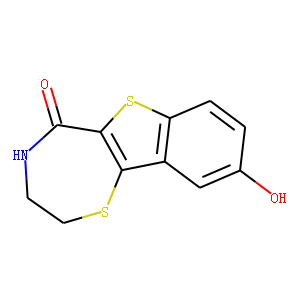| Reference | <p style=/line-height:25px/>
<br>[1]. Young SH, Rozengurt N, Sinnett-Smith J, et al. Rapid protein kinase D1 signaling promotes migration of intestinal epithelial cells. Am J Physiol Gastrointest Liver Physiol. 2012 Aug 1;303(3):G356-66.
Abstract
We have examined the role of protein kinase D1 (PKD1) signaling in intestinal epithelial cell migration. Wounding monolayer cultures of intestinal epithelial cell line IEC-18 or IEC-6 induced rapid PKD1 activation in the cells immediately adjacent to the wound edge, as judged by immunofluorescence microscopy with an antibody that detects the phosphorylated state of PKD1 at Ser(916), an autophosphorylation site. An increase in PKD1 phosphorylation at Ser(916) was evident as early as 45 s after wounding, reached a maximum after 3 min, and persisted for ≥15 min. PKD1 autophosphorylation at Ser(916) was prevented by the PKD family inhibitors kb NB 142-70 and CRT0066101. A kb NB 142-70-sensitive increase in PKD autophosphorylation was also elicited by wounding IEC-6 cells. Using in vitro kinase assays after PKD1 immunoprecipitation, we corroborated that wounding IEC-18 cells induced rapid PKD1 catalytic activation. Further results indicate that PKD1 signaling is required to promote migration of intestinal epithelial cells into the denuded area of the wound. Specifically, treatment with kb NB 142-70 or small interfering RNAs targeting PKD1 markedly reduced wound-induced migration in IEC-18 cells. To test whether PKD1 promotes migration of intestinal epithelial cells in vivo, we used transgenic mice that express elevated PKD1 protein in the small intestinal epithelium. Enterocyte migration was markedly increased in the PKD1 transgenic mice. These results demonstrate that PKD1 activation is one of the early events initiated by wounding a monolayer of intestinal epithelial cells and indicate that PKD1 signaling promotes the migration of these cells in vitro and in vivo.
<br>[2]. Ya Fu1, Charles S Rubin. Protein kinase D: coupling extracellular stimuli to the regulation of cell physiology. EMBO reports (2011) 12, 785 – 796
Abstract
Protein kinase D (PKD) mediates the actions of stimuli that promote diacylglycerol (DAG) biogenesis. By phosphorylating effectors that regulate transcription, fission and polarized transport of Golgi vesicles, as well as cell migration and survival after oxidative stress, PKDs substantially expand the range of physiological processes controlled by DAG. Dysregulated PKDs have been linked to pathologies including heart hypertrophy and cancer invasiveness. Our understanding of PKD regulation by trans- and autophosphorylation, as well as the subcellular dynamics of PKD substrate phosphorylation, have increased markedly. Selective PKD inhibitors provide new, powerful tools for elucidating the physiological roles of PKDs and potentially treating cardiac disease and cancer.
<br>[3]. George, Kara M.; Frantz, Marie-Celine; Bravo-Altamirano, Karla et al. Design, synthesis, and biological evaluation of PKD inhibitors. Pharmaceutics (2011), 3, 186-228.
Abstract
Protein kinase D (PKD) belongs to a family of serine/threonine kinases that play an important role in basic cellular processes and are implicated in the pathogenesis of several diseases. Progress in our understanding of the biological functions of PKD has been limited due to the lack of a PKD-specific inhibitor. The benzoxoloazepinolone CID755673 was recently reported as the first potent and kinase-selective inhibitor for this enzyme. For structure-activity analysis purposes, a series of analogs was prepared and their in vitro inhibitory potency evaluated.
<br>[4]. Lavalle CR, Bravo-Altamirano K, Giridhar KV et al. Novel protein kinase D inhibitors cause potent arrest in prostate cancer cell growth and motility. BMC Chem Biol. 2010 May 5;10:5. doi: 10.1186/1472-6769-10-5.
Abstract
BACKGROUND: Protein kinase D (PKD) has been implicated in a wide range of cellular processes and pathological conditions including cancer. However, targeting PKD therapeutically and dissecting PKD-mediated cellular responses remains difficult due to lack of a potent and selective inhibitor. Previously, we identified a novel pan-PKD inhibitor, CID755673, with potency in the upper nanomolar range and high selectivity for PKD. In an effort to further enhance its selectivity and potency for potential in vivo application, small molecule analogs of CID755673 were generated by modifying both the core structure and side-chains. RESULTS: After initial activity screening, five analogs with equal or greater potencies as CID755673 were chosen for further analysis: kb-NB142-70, kb-NB165-09, kb-NB165-31, kb-NB165-92, and kb-NB184-02. Our data showed that modifications to the aromatic core structure in particular significantly increased potency while retaining high specificity for PKD. When tested in prostate cancer cells, all compounds inhibited PMA-induced autophosphorylation of PKD1, with kb-NB142-70 being most active. Importantly, these analogs caused a dramatic arrest in cell proliferation accompanying elevated cytotoxicity when applied to prostate cancer cells. Cell migration and invasion were also inhibited by these analogs with varying potencies that correlated to their cellular activity. CONCLUSIONS: Throughout the battery of experiments, the compounds kb-NB142-70 and kb-NB165-09 emerged as the most potent and specific analogs in vitro and in cells. These compounds are undergoing further testing for their effectiveness as pharmacological tools for dissecting PKD function and as potential anti-cancer agents in the treatment of prostate cancer.
</p>
|

